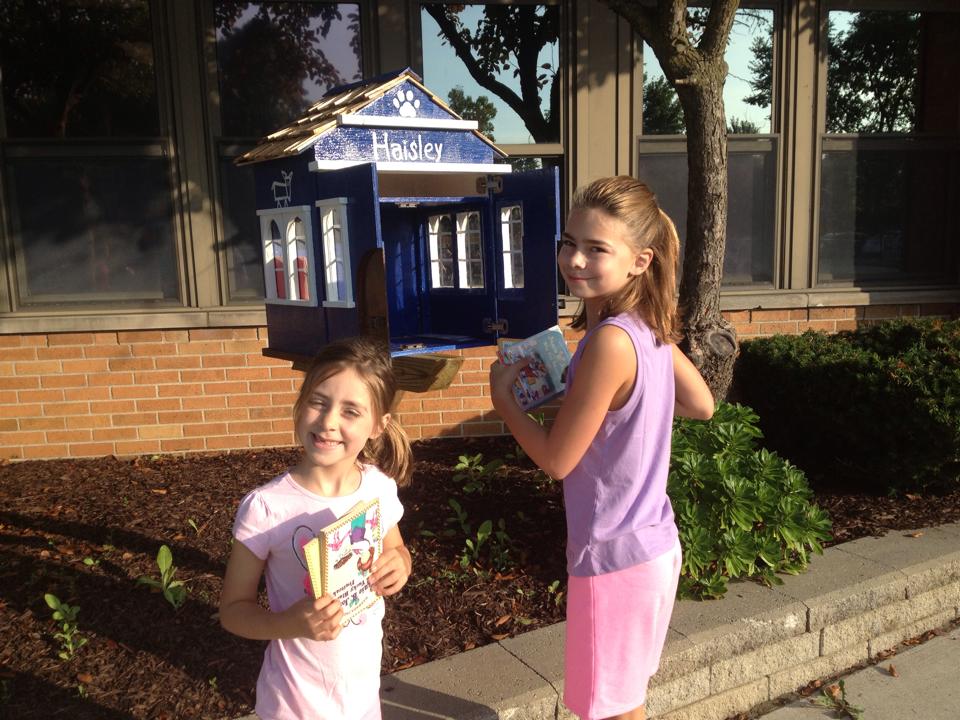by Donna Iadipaolo
THIS FALL, HAISLEY Elementary School became the first school in the Ann Arbor Public Schools (AAPS) to participate in the national “Little Free Library” (LFL) program.
The Little Free Library movement began in 2009 by Todd Bol of Hudson, Wisconsin. He built a small model of one-room school house, filled it with books, and post it in his front yard. He then he built several more. His friends and neighbors loved it.
Rick Brooks from the University of Wisconsin-Madison eventually joined the effort. According to Hudson and Brooks, they were inspired by Andrew Carnegie’s support of 2,509 free libraries, “take a book, leave a book” collections in coffee shops and public spaces, and grassroots empowerment movements, along with other influences.
According to the LFL website, by January 2014, the total number of registered Little Free Libraries in the world was estimated around15,000.
Haisley parent Ruthann Thorne’s brother built a little structure and it was placed in front of the school so that people could share books with one another via the small home. The miniature house in front of Haisley is painted royal blue and white, the school’s colors, and also has windows, trim, and flattering wood shingles.
“It is a standing structure in front of Haisley Elementary that will allow for the Haisley Community (neighbors, family, friends, staff, and the student body) to share books,” said Thorne. “From the (national) LFL website, it’s a ‘take a book, return a book’ gathering place where neighbors share their favorite literature and stories. In its most basic form, a Little Free Library is a box full of books from which anyone may pick up a book or two and bring back another book to share.”
This program grew from an inspiration from the current Haisley PTO president and other like-minded community members, and garnered a great deal of consequential support.
“The idea was discovered by PTO President Jimmy (Simonte), they’ve been popping up all over the country, and he really wanted to be the first school in Ann Arbor to get one,” said Thorne. “We read a lot in our family, so it was a natural fit and I was an early supporter of the project.”
The Haisley Little Free Library, in part, grew out of some people sharing a common, positive vision. Studies show that students who are active readers at a early age are more apt to be life-long readers. Reading throughout one’s life is, of course, important for a whole host of civic, educational, and intellectual pursuits.

“Last Spring a few folks in the Haisley community became aware of the LFL movement,” according to Simonte. “We were enamored and immediately started discussing plans for bringing LFL to Haisley.”
Simonte added that everyone seems to love the result of the first LFL for the AAPS.
“The library at any given time can have all different books in it today, then it will tomorrow. It is magical,” added Thorne. “The concept is take a book, leave a book. There are 50 bookmarks inside the Library to explain the project. We hope to have one at each neighborhood that feeds into Haisley.”
The benefits that people cite thus far of the LFL at Haisley are community building, literacy building, and service.
“It’s great to hear the children talking about sharing their books,” said Thorne.
The PTO covered the cost of the structure that stands in front of the school. And Thorne commissioned a family member who is a craftsman to build it without any labor costs.
“$250 was the cost to the PTO,” confirmed Thorne, “My brother Paul Tocco donated all of the labor and drove it personally from Upstate New York this past August. He is so proud of his first inspired LFL. He was very glad to help his niece’s school make the dream a reality.”
The total cost was lower then what this structure typically retail.
“The national website littlefreelibrary.org sells prefab units for $300-$500,” said Simonte. “By seeking out an independent carpenter we were able to build the first Haisley LFL for much less.”
Simonte agreed that there were many positive aspects to the project.
“At it’s core, LFL is about promoting literacy in our community,” said Simonte. “It adds a sense of discovery to reading and hopefully, fosters community.”
The LFLs are extremely popular in many other communities in Michigan and throughout the nation.
“To me, one of the most magical elements of LFLs is their ability to surprise and delight,” revealed Simonte. “Since becoming aware of the idea I’ve stumbled upon LFLs in unexpected places like a park in downtown Boston and a bike trail in Petoskey. The unexpected nature of each discovery adds to the charm. And each LFL is unique; some designed as miniature versions of an architectural landmarks, others simply sweet, artistic vessels of their own design. It helps to put reading in an entertaining light. Its a relatively small way to have a huge impact.”
There are plans to build other LFL throughout the Haisley neighborhoods.
“We hope that the LFL will be the first at the Ann Arbor District, but not the last and children will be sharing books and their love literacy for years to come,” concluded Thorne.

